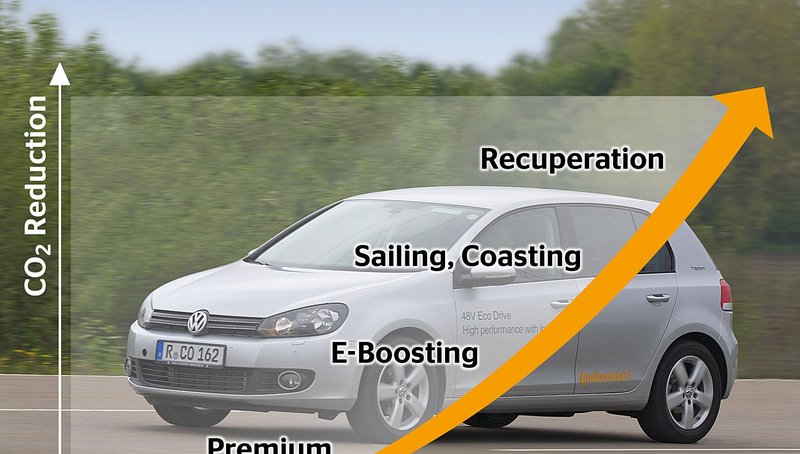Giving Engines a Break: Continental’s "48-Volt Eco Drive" Technology Significantly Reduces Fuel Consumption
- The new 48-volt hybrid system can be easily integrated into vehicles with conventional drives – making it possible to offer all-electric driving features such as "sailing", which up to now have only been available in high-voltage hybrid systems.
- Based on a test drive under mainly urban conditions using the Continental demo vehicle, the "auto mobil" magazine on German TV station VOX shows a fuel saving of 21 percent.
- The Continental system will go into production with European car manufacturers from 2016.
- Global market share of 48-volt vehicles is to grow to more than 10 percent by 2025.
- A new Continental video shows how the "48-Volt Eco Drive" works.
Regensburg, November 12, 2014. Next to optimizing combustion engines, the electrification of the powertrain – from fuel-saving start-stop functionality to all-electric drive – plays one of the key roles in reducing fuel consumption and emissions. However, up to now, within this spectrum of electrification possibilities, there has been a huge gap between the reasonably priced 12-volt start-stop systems and the more expensive hybrid solutions with voltages from 110 volts. The international automotive supplier Continental has now closed this gap with its "48-Volt Eco Drive" system. The new hybrid technology combines the best of two worlds: it can be easily integrated into the architecture of conventional-drive vehicles, yet, at the same time, it provides features that up to now have only been found in high-voltage hybrid systems – such as switching off the combustion engine while driving (“sailing”, "coasting"), extremely quick and comfortable premium engine start-up and efficient brake energy recovery (recuperation).
The new Continental technology will go into production with European car manufacturers for the first time in 2016. The fuel-saving potential offered by the system will be demonstrated on the "auto mobil" magazine, a program which will be shown on German TV station VOX at 5:00 p.m. on November 16. The VOX editors tested the Continental demo vehicle – a standard compact car with a 1.2-liter gasoline engine fitted with the "48-Volt Eco Drive" system – under real conditions in a mainly urban environment. The result: A 21-percent fuel saving compared to the standard version with a 12-volt start-stop system.
"This shows the enormous potential of our 48-volt hybrid system regarding fuel consumption and emissions," says Dr. Carsten Götte, in charge of the development of on-board power supply stabilization systems in the Hybrid Electric Vehicle Business Unit of the Continental Powertrain Division. "The highest savings can be achieved in the urban environment, although the system also reduces consumption on country roads and expressways through engine switch-off and recuperation. According to our measurements, the average consumption according to the New European Driving Cycle (NEDC) is around 13 percent lower than with a conventional combustion system without start-stop functionality."
Particularly High Demand Expected for Compact and Midsize Class Vehicles
Continental supplies systems for all stages of drive electrification, from 12-volt start-stop technology to the complete powertrain for electric vehicles. The new 48-volt hybrid system is another key part of the "electrification tailored to fit” strategy. This new technology is extremely economical because it can be easily integrated into an existing vehicle architecture and the small 48-volt battery means battery costs are reasonable," says Christopher Breitsameter, Head of Business Development & Strategy in the Powertrain Division. "Car manufactures are demanding low-price 'clean power' solutions at an attractive system price in the lower double-digit euro range per gram of CO2 reduction – and our '48-Volt Eco Drive' system fits the bill exactly."
Breitsameter goes on to say that the system is ideal for use in all vehicle classes. "However, we assume the greatest demand will come from the large-volume segments of compact and midsize class vehicles, since the cost here of electrifying the powertrain is very high." In view of the impending reduction of fleet emission to an average 95 grams of CO2 per kilometer, Europe will probably take on a pioneering role in the introduction of the 48-volt technology. "We expect other regions to follow soon, leading to a rapid increase in global demand." According to estimates within the industry, around 20 percent of new vehicles worldwide will have electrified drive systems by 2025 – with around half of these being 48-volt hybrids.
Less Effort, More Efficiency
In the "Eco Drive" system from Continental, the 48-volt on-board power supply – which supplements the 12-volt supply – consists of three components: an electric motor with integrated inverter which replaces the generator, a 48-volt lithium ion battery, and a voltage converter (DC/DC converter) for exchanging energy between the two on-board power supplies. Major intervention in the vehicle system is not necessary, since a 48-volt supply does not require any contact protection measures; these are only prescribed with voltages from 60 volts upwards.
The electric motor in the current Continental demo vehicle is a belt-starter generator with integrated power electronics. The electric motor – which can be built directly onto the transmission as an option – supplies the 48-volt on-board power supply, provides electromotive support for the drive system (during "e-boosting" and "coasting", see below) and starts the combustion engine extremely quietly and twice as fast (in less than 0.2 seconds).
The 48-volt on-board power supply also offers numerous advantages in terms of further energy-saving measures and new electric features. Electric consumers with a larger energy requirement can thus be operated more efficiently at 48 volts. In addition, this high efficiency allows 48-volt consumers to be built lighter, reducing vehicle weight. And as far as larger vehicles in particular are concerned, where the conventional 12-volt on-board power supply is already reaching its performance limits, new features such as an electric air-conditioning compressor or electric rolling stabilization (active restriction of lateral tilting when the car is cornering) are extremely difficult to achieve without additional voltage.
Effective Recuperation and Engine Switch-off During Driving
The "48-Volt Eco Drive" offers significantly more effective recuperation than 12-volt systems. The recuperated energy is stored in the powerful Li-ion battery and makes a key contribution to fuel reduction. And the recuperation performance can be optimized even further in future applications, for example in combination with the Continental eHorizon (electronic horizon) system, which prepares a three-dimensional profile of the route on the basis of topographical data and the GPS signal. This allows engine management to determine in advance where energy can be recovered en route and how this energy can best be used.
The new 48-volt hybrid system also reduces fuel consumption by extending the start-stop functionality to driving mode – the combustion engine is switched off for almost a third of the time in total. The 48-volt supply supports the 12-volt on-board power supply and ensures that all the electric features are maintained. In contrast, conventional 12-volt start-stop systems often have to restart the engine in order to operate energy-intensive consumers (e.g. air-conditioning unit) or do not switch the engine off at all when the vehicle is at a standstill.
"Coasting", "Sailing" and "E-boosting" – Video Demonstration
The "48-Volt Eco Drive" switches the combustion engine off as soon as the driver takes his foot off the accelerator pedal. This disengages the powertrain from the engine, so that the vehicle rolls freely. The system switches to this "coasting" mode not only in urban traffic, such as when approaching traffic lights, but also at higher speeds. "If you are overtaking at 120 km/h on the expressway and take your foot off the accelerator, the vehicle's energy is sufficient enough to allow you to keep up with the traffic and continue with the overtaking maneuver," Carsten Götte explains. This example is shown in a new Continental video, where Götte explains this technology. During an average trip, the system is in "coasting" mode around 20 to 25 percent of the time, which alone saves up to 8 percent of fuel.
The video also explains the two "48-Volt Eco Drive" features where the belt-starter generator acts as a drive unit. In "sailing" mode – with the combustion engine switched off as in the "coasting" mode – the electric motor keeps the speed of the vehicle consistent for a brief time. And during "e-boosting" the electric motor supports the combustion engine during acceleration, which can compensate for turbo lag, for example.
Premium Comfort during Engine Start-Up
No matter whether the combustion engine is switched off during "coasting", the electric motor provides support in "e-boosting" or "sailing" turns into "coasting", the driver hardly notices anything during the transition between the driving modes. This also applies to starting the combustion engine after the switch-off phases, which takes place very quickly, quietly, and with very little vibration. Götte: "Next to efficiency and economy, this premium comfort during engine start-up is a further important advantage of our new 48-volt system."

Simone Geldhäuser
Head of Media Relations, Spokesperson Finance, Business and Technology
Vitesco Technologies
